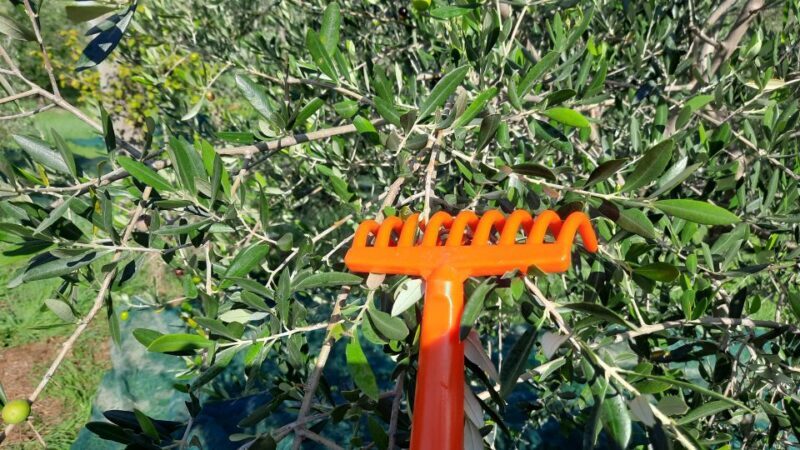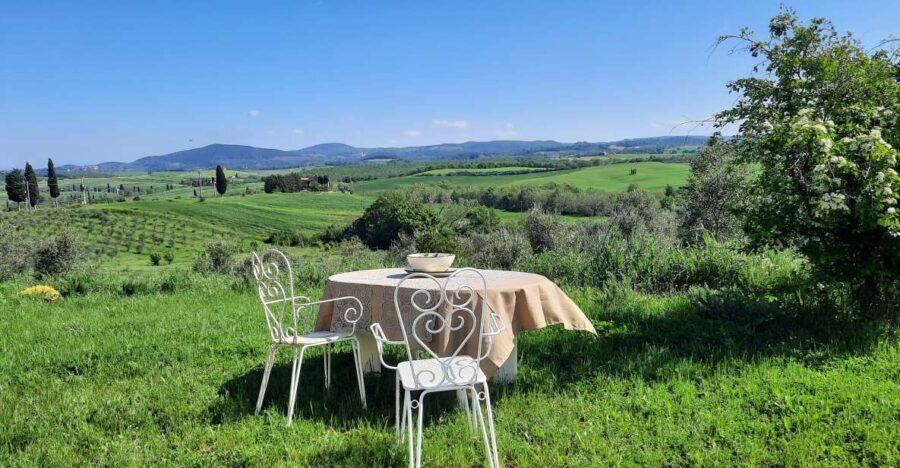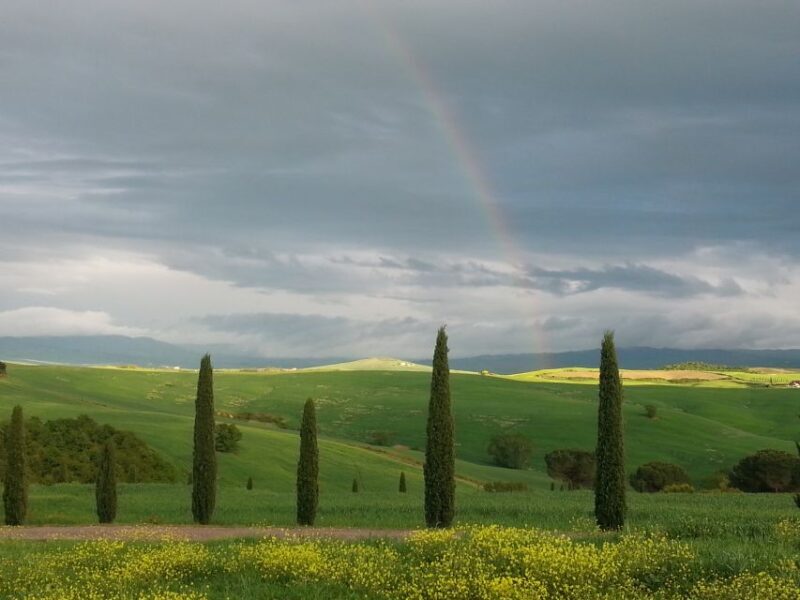Walking through an olive grove reveals a fascinating world of meticulous craftsmanship behind extra virgin olive oil. It’s not just about picking ripe olives; it’s a journey that starts with careful harvesting and ends with a rich, flavorful liquid. Each step, from the grove to the press, plays a crucial role in determining the oil’s quality. Curious about what happens next in this captivating process?
Key Points

- Olives are hand-picked or mechanically harvested to ensure quality and minimize damage during collection.
- Harvested olives are quickly transported to prevent fermentation and maintain freshness.
- After inspection, olives are cleaned to remove impurities before the extraction process begins.
- Crushing the olives into a paste and malaxation enhances oil extraction efficiency.
- Centrifugation separates the oil from water and solids, resulting in high-quality extra virgin olive oil.
The Olive Tree: A Vital Component of Olive Oil Production

The olive tree stands as a vital component in the world of olive oil production, cherished for its resilience and longevity.
Grown in Mediterranean climates, these trees thrive in rocky soils and endure harsh conditions, making them a symbol of endurance. Each tree produces fruit rich in healthy fats, which are essential for high-quality extra virgin olive oil.
The process begins with nurturing the trees, ensuring they’re well-cared for to yield the best olives. Their unique characteristics not only influence the flavor but also the nutritional profile of the oil, showcasing the tree’s importance in this ancient, beloved tradition.
You can also read our reviews of more tours and experiences in Pienza.
Harvesting Olives: Methods and Techniques

Once the olive trees have matured and produced their fruit, the next exciting phase begins: harvesting olives.
As olive trees reach maturity, the thrilling process of harvesting olives commences, marking a vibrant new chapter in their journey.
Farmers use various methods to ensure a successful harvest, each with its unique benefits. Here are three popular techniques:
-
Hand-picking: This traditional method involves carefully selecting olives, minimizing damage, and ensuring only the best fruit is harvested.
-
Mechanical harvesters: These machines shake the branches, collecting olives efficiently and quickly, perfect for larger groves.
-
Netting: Placing nets beneath trees catches falling olives, making collection easier and reducing waste.
Each method reflects the commitment to quality and the art of olive oil production.
The Journey of Olives: From Grove to Press

As olives make their way from the grove to the press, their journey is filled with careful steps that ensure the highest quality oil. After harvesting, olives are swiftly transported to avoid fermentation. Each batch is inspected for ripeness and quality before being cleaned.
| Step | Purpose | Key Action |
|——————–|——————————|———————–|
| Harvesting | Collect ripe olives | Hand-picking or shaking|
| Transporting | Preserve freshness | Quick delivery |
| Inspecting | Ensure quality | Sorting and checking |
| Cleaning | Prepare for pressing | Remove leaves and dirt|
These meticulous processes set the stage for producing exceptional extra virgin olive oil.
The Extraction Process: How Extra Virgin Olive Oil Is Made
After olives have been carefully harvested and prepared, the extraction process begins, turning those fresh fruits into the liquid gold known as extra virgin olive oil.
The journey from freshly harvested olives to exquisite extra virgin olive oil is a meticulous process of transformation.
This process involves a few key steps:
-
Crushing: The olives are crushed into a paste, releasing their oil.
-
Malaxation: The paste is mixed to encourage oil droplets to merge, enhancing extraction.
-
Separation: Finally, the oil is separated from the water and solids, typically using centrifugation.
These steps transform simple olives into a flavorful oil, capturing their essence and providing a taste of the Mediterranean in every drop.
More Great Tours NearbyUnderstanding Quality: What Makes Extra Virgin Olive Oil Special
Extra virgin olive oil stands out in the culinary world for its exceptional quality and rich flavor profile. Its unique characteristics stem from meticulous production methods, ideal growing conditions, and the careful selection of olives.
| Quality Factor | Description | Importance |
|———————-|———————————|——————————-|
| Acidity Level | Must be below 0.8% | Indicates freshness |
| Flavor Complexity | Rich, fruity, and sometimes peppery | Enhances culinary dishes |
| Harvesting Method | Hand-picked olives | Preserves quality and integrity |
These elements combine to create a product that not only elevates dishes but also boasts health benefits, making it a staple in kitchens worldwide.
Tasting the Difference: Sampling Olive Oil and Local Delicacies
Have you ever wondered how the flavors of olive oil can transform local delicacies into extraordinary culinary experiences? Sampling olive oil offers a delightful journey for the palate.
Here are three ways to savor these flavors:
-
Bruschetta Bliss: Enjoy freshly toasted bread drizzled with extra virgin olive oil, enhancing its natural taste.
-
Wine Pairing: Complement the olive oil tasting with a local wine, elevating the experience.
-
Olive Oil Education: Learn about the various olive oil types and their distinct flavor profiles, making each tasting memorable.
These experiences not only tantalize the taste buds but also deepen appreciation for this liquid gold.
The Role of Terroir: How Environment Influences Flavor
Terroir plays a crucial role in shaping the flavor profiles of olive oil, as the environment where olive trees thrive significantly influences their taste.
Factors like soil composition, climate, and altitude contribute to the unique characteristics of each oil. For instance, a hot, dry climate might produce olives with a more robust, peppery flavor, while cooler areas tend to yield milder, fruitier oils.
Plus, the specific varieties of olives grown can enhance these traits. Understanding terroir helps enthusiasts appreciate the nuances in each bottle, making every tasting experience a delightful exploration of nature’s influence on culinary art.
Sustainable Practices in Olive Farming and Oil Production
As consumers become more conscious of their choices, sustainable practices in olive farming and oil production are gaining traction. Farmers are adopting methods that protect the environment while ensuring high-quality oil.
Here are three key practices:
-
Organic Farming: Avoiding synthetic pesticides and fertilizers promotes healthier soil and biodiversity.
-
Water Conservation: Implementing drip irrigation systems reduces water waste and supports sustainable growth.
-
Crop Rotation: Alternating olive trees with other crops helps maintain soil health and prevents pest infestations.
These practices not only enhance the quality of olive oil but also contribute to a more sustainable future for the industry.
Since Your Asked
What Are the Health Benefits of Extra Virgin Olive Oil?
Extra virgin olive oil’s packed with antioxidants, promoting heart health and reducing inflammation. It supports weight management and enhances digestion. Regular use can improve skin health, making it a tasty addition to a balanced diet.
How Do I Choose Quality Extra Virgin Olive Oil?
To choose quality extra virgin olive oil, he suggests checking for a harvest date, looking for dark bottles, and seeking certifications. Tasting it fresh, fruity, and slightly bitter is essential for a premium experience.
Can Extra Virgin Olive Oil Go Bad?
Extra virgin olive oil can indeed go bad. It usually spoils due to light, heat, and air exposure, which causes rancidity. Proper storage in a cool, dark place helps maintain its quality and flavor longer.
What Are Common Uses for Extra Virgin Olive Oil in Cooking?
Extra virgin olive oil’s commonly used for drizzling on salads, enhancing marinades, and sautéing vegetables. It adds depth to pasta dishes and can even elevate desserts, making it a versatile staple in any kitchen.
How Does Climate Affect Olive Oil Production?
Climate greatly influences olive oil production. Warmer temperatures enhance olive ripening, while adequate rainfall is crucial for healthy trees. Plus, extreme weather can affect yield, leading to variations in flavor and quality of the oil.
The Last Word
Walking through the olive grove reveals the intricate journey from tree to table. Each step, from hand-picking ripe olives to the careful extraction of oil, showcases the dedication of producers committed to quality. Extra virgin olive oil isn’t just a cooking staple; it’s a vibrant reflection of the land and its care. So next time you drizzle that golden liquid, remember the artistry and passion behind it—it’s more than just oil; it’s a story waiting to be savored.
You can check availability for your dates here: